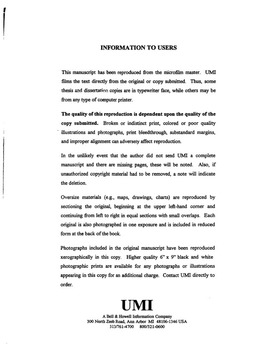| dc.contributor.advisor | Fung, Bing-Man, | en_US |
| dc.contributor.author | Zhao, Jing. | en_US |
| dc.date.accessioned | 2013-08-16T12:29:53Z | |
| dc.date.available | 2013-08-16T12:29:53Z | |
| dc.date.issued | 1997 | en_US |
| dc.identifier.uri | https://hdl.handle.net/11244/5561 | |
| dc.description.abstract | Another subject of this work in chapter 4 is the binding of chromate anions by polymeric surfactants, namely polyethyleneimine (PEI), hexyl PEI and lauryl PEI. PEI, one of the most widely studied polyelectrolytes, is known to be a highly branched water-soluble polyamine of variable molecular weight. It is believed to contain primary, secondary, and tertiary amine groups in the ratio of approximately 1:2:1. Owing to its cationic character, in aqueous solution PEI exhibits a strong affinity to anionic materials, including organic and inorganic anions and polyanions. Hexyl PEI and lauryl PEI were synthesized in this work from PEI and alkyl bromide. A series of ultrafiltration experiments were then performed in which chromate ions were bound by PEI, hexyl PEI and lauryl PEI at various pH values and chromate to EI ratios. | en_US |
| dc.description.abstract | This dissertation deals with three types of cationic surfactants, i.e., monomeric, dimeric and polymeric surfactants. | en_US |
| dc.description.abstract | Dimeric surfactants, which are also referred to as gemini or bipolar surfactants, are made up of two identical amphiphilic moieties connected by a spacer near the head group. Most of the studies published so far are concerned with dimethylalkylammonium halide type which are referred to as m-s-m, 2X- surfactants, where s and m are the carbon numbers of the alkanediyl spacer and of the alkyl chain of the hydrocarbon chain, respectively, and X- is the halide counterion. One of the interesting properties of the dimeric surfactants is their co-micellization with conventional surfactants. Synergism was reported for the mixed dimeric and conventional surfactant systems. In chapter 2 and 3 of this dissertation, the study of binary mixed monomeric and dimeric surfactant systems is described. Five bis(quaternary ammonium bromide) surfactants (m-s-m 2Br$\sp-), $ namely 12-2-12, 14-2-14, 16-2-16, 16-4-16 and 16-6-16 were synthesized, and a series of conductivity measurements were performed to obtain the Krafft temperatures and cmc's of all five pure dimeric surfactants and their mixtures with cetyltrimethylammonium bromide (CTAB). | en_US |
| dc.format.extent | xvi, 320 leaves : | en_US |
| dc.subject | Surface active agents. | en_US |
| dc.subject | Chemistry, Polymer. | en_US |
| dc.subject | Chemistry, Analytical. | en_US |
| dc.title | Monomeric, dimeric, and polymeric cationic surfactants. | en_US |
| dc.type | Thesis | en_US |
| dc.thesis.degree | Ph.D. | en_US |
| dc.thesis.degreeDiscipline | Department of Chemistry and Biochemistry | en_US |
| dc.note | Source: Dissertation Abstracts International, Volume: 58-10, Section: B, page: 5369. | en_US |
| dc.note | Adviser: Bing-Man Fung. | en_US |
| ou.identifier | (UMI)AAI9812250 | en_US |
| ou.group | College of Arts and Sciences::Department of Chemistry and Biochemistry | |
